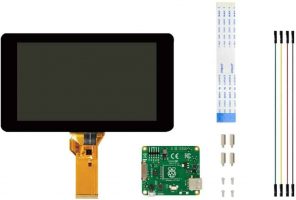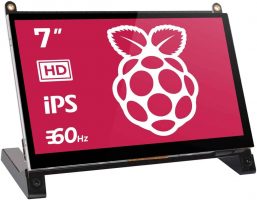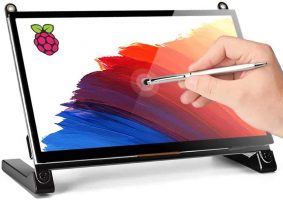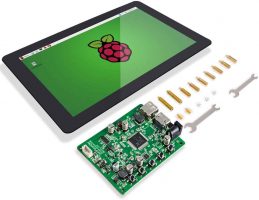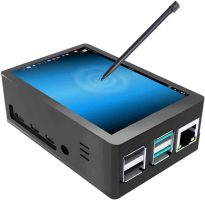Best Raspberry Pi Touchscreen in 2021
Bring your all-in-one projects to life with the best Raspberry Pi touchscreens
- Last Updated Jun 4, 2021
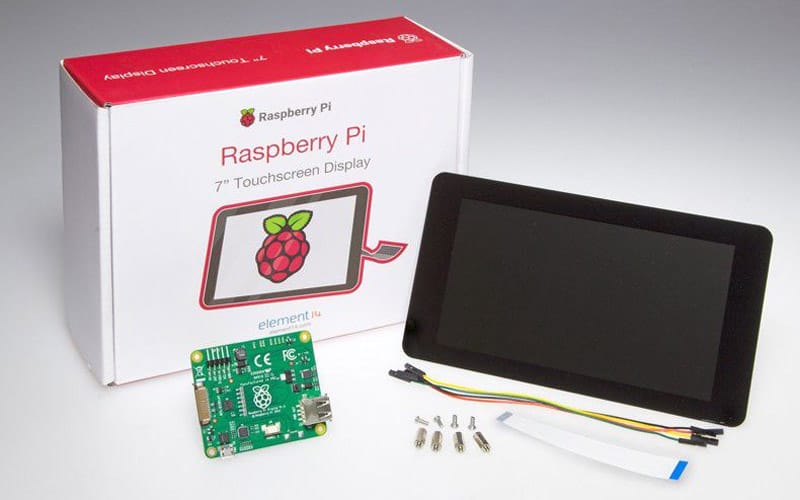
With over 30 million units and counting sold since bursting onto the computing scene back in 2012, the Raspberry Pi continues to be prized for its versatility, small form factor, modularity, and, of course, an enticingly low price tag. With each new iteration proposed by the folks at the Raspberry Pi Foundation, this mini but mighty computer continues to expand to an ever more diverse range of case uses, from robotics and monitoring systems to education by way of hobbyists DIY projects and everything in between.
If you’ve taken the plunge to see what all the fuss is about and secured a Raspberry Pi kit, you’ll likely be looking to source the last piece of the puzzle: a screen, and more than likely, one of the touch variety.
While Raspberry Pi’s popularity is a boon for computer and electronics enthusiasts, it does mean new parts, including screens, arrive each year to offer even more options to Pi fans. Sorting through these to find the best screen for your project can be a daunting task and one that can quickly sap the fun out of building and working with a Raspberry Pi.
To simplify the task, we’ve penned a guide featuring a selection of recommendations for the best Raspberry Pi Touchscreen out there.
Products at a Glance
How We Picked
Pick a touch screen (ideally the cheapest), hook it up to the Raspberry Pi, and bob’s your uncle, right? If only choosing a touch screen was that simple. There are differences between models that dictate whether you’ve a winner or a waste-of-time dud on your hands.
In particular, the combination of size, refresh rate, resolution, colors, brightness, connectivity, panel type, viewing angles, and additional features like built-in speakers or stands/cases shape how well a touch screen will perform alongside a Raspberry Pi.
After scouring what’s out there, five Raspberry Pi touch screen’s caught our attention. Below, there’s a short review of each, highlighting what they bring to the table, and if you need a little more guidance on what to look for, we’ve pieced together a ‘Things to Consider’ section at the end.
Best Raspberry Pi Touchscreen in 2021
7-inch display
Easy installation
10-finger touch commands
Official Raspberry Pi part
800 x 480 resolution may be too low for some projects
No case or stand
Manufactured by none other than Raspberry (which helps ward off the justified concerns that come hand in hand with buying from a third-party manufacturer), the Raspberry Pi 7″ Touch Screen Display offers a full-color 7-inch display, as the name implies, alongside an 800 x 480 resolution.
The form factor and four screw/four standoff Raspberry Pi mounting bracket on the back makes it particularly suited for portable projects where an all-in-one solution is needed, like embedded systems, automation devices, and tablets.
Ease of use is baked into the Raspberry Pi 7″ Touch Screen Display. It requires no more than two connections thanks to an included adapter board that manages power, signal conversion, and touch input – power through the GPIO or USB and a ribbon cable to the DSI port, both on the Pi itself. As such, no extra adapter is needed to power the touch screen.
The Raspberry Pi 7″ Touch Screen Display records up to 10-finger touch commands. In practice, we found the display sufficiently bright, with good color accuracy and excellent finger responsiveness. The only real issue is the low-ish resolution rate compared to other 7-inch Raspberry Pi touch screens, which won’t suit all project types. It doesn’t ship with a case or stand, so factor in the cost of sourcing one.
Sold for roughly $70, the Raspberry Pi 7″ Touch Screen Display is competitively priced, too. As we mentioned above, you have the reassurance of buying directly from the manufacturer of the Raspberry Pi itself. The touch screen is also compatible with all existing Raspberry Pi models.
7-inch display
1024 x 600 resolution
Prop stands
IPS panel
Price
Stands for landscape viewing only
Equipped with an IPS panel, which offers better viewing angles (up to 178-degrees here) and higher color accuracy than other equivalent panel types, the EVICIV 7 Inch Touchscreen Monitor delivers one of the best viewing experiences of all our recommendations. Alongside, it can support resolutions up to 1920 x 1080 with 1024 x 600 as the recommended resolution, has a 60 Hz refresh rate and 16:9 aspect ratio.
The touch screen is well calibrated and responsive to multi-touch commands such as swipe, zoom, scroll, etc. We’re particularly taken by the auto-rotate function that mimics the automatic landscape/portrait swapping found on smartphones and tablets. The EVICIV 7 Inch Touchscreen Monitor also boasts a pair of built-in speakers, which produce a decent max volume suitable for watching streaming services and the like. USB, Micro-HDMI, HDMI ports allow for easy second or extended screen integration, too.
Alongside compatibility with the Raspberry Pi 4/3/2/1/3B+/BB and Banana Pi, the EVICIV 7 Inch Touchscreen Monitor fares just as well with Windows PC, Mac, and even games consoles such as the Nintendo Switch, PlayStation 4, and Xbox One. Whether this proves useful in most Raspberry Pi projects is debatable, but we certainly won’t scoff at such widespread compatibility.
The EVICIV 7 Inch Touchscreen Monitor ships with an integrated adapter board on the back and mounts for the Raspberry PI, as well as a pair of screw-on stands that support the touch screen/ Pi to save space, although they are only suitable for landscape viewing, which hampers the versatility of the screen somewhat.
7-inch display
1024 x 600 IPS Panel
Dual Speakers
Stands
Competitive price
Stands force landscape mode
Stands obstruct access to ports
Another quality 7-in touchscreen for Raspberry Pi, the Lebula Raspberry Pi Touchscreen Monitor, bears an uncanny resemblance in both design and specifications to the EVICIV 7 Inch Touchscreen Monitor. For all intents and purposes, they are virtually the same touch screen, simply manufactured by different companies. Not a bad thing considering how impressed we were with the EVICIV model.
The Lebula Raspberry Pi Touchscreen Monitor incorporates an IPS panel, with all the benefits to color quality and viewing angles that this entails, a resolution of 1024 x 600 (supports up to 1920 x 1080 with great results), a 60 Hz refresh rate, easy Raspberry Pi back mounting, micro USB and HDMI ports, and, the welcome addition of a stylus. Dual speakers deliver decent quality audio with more than acceptable volume levels.
The Lebula Raspberry Pi Touchscreen Monitor incorporates a five-point capacitive touch technology with 3-5 ms response times. In our experience, it is one of the more comfortable and snappy touch screens for Raspberry Pi we’ve come across. You’ll find that common commands such as tap, swipe, press, and zoom work well.
The screen has the same stand setup as the EVICIV 7 Inch Touchscreen Monitor; easy to set up and convenient, but it forces users to keep the screen in landscape mode. The stand also leaves very little leeway for connecting to the HDMI and micro USB ports, which may frustrate those intent on using their Raspberry Pi in dual screen arrangements.
10-inch display
1280 x 800 resolution
HDMI
OS compatibility
10-finger multi-touch
Expensive
The SunFounder Raspberry Pi 10 Inch Touchscreen supersizes any all-in-one Raspberry Pi projects with a big 10-inch touch screen. It’s the largest of our recommendations and is firmly aimed at those that need plenty of on-screen real estate.
SunFounder Raspberry Pi 10 Inch Touchscreen features an IPS LCD panel capable of a resolution of 1280 x 800, a speaker, wide 178-degrees viewing angle, fast response times, good color accuracy as well as picture quality. The SunFounder Raspberry Pi 10 Inch Touchscreen allows you to power your Raspberry Pi directly from the touch screen, a convenient solution for portable projects.
One notable feature that sets the SunFounder Raspberry Pi 10 Inch Touchscreen apart from the competition beyond its size is a Raspberry Pi camera module v2 holder mounted on the top of the screen. Additionally, the back of the screen includes a case for the Pi itself, alongside an enclosed adapter module with VGA and HDMI ports and power/menu/volume/and mode select buttons.
The SunFounder Raspberry Pi 10 Inch Touchscreen is one the most widely OS-compatible touch screens with support for Ubuntu, Chromium OS, Windows, Raspbian, Android, and Debian.
As Raspberry Pi screens go, the SunFounder Raspberry Pi 10 Inch Touchscreen is priced high at $150, a point to consider when budgeting for a project.
Low cost
3.5-inch display
320 x 480 resolution
Protective case
Driver troubleshooting
Runs hot
Construction quality
At $30, don’t expect the world from the Jun-Electron 3.5 inch Touchscreen. It’s a functional touch screen that won’t turn heads or win awards and certainly had its share of flaws, but we aren’t ones to complain at such a low price point, considering most of the other Raspberry Pi touch screens cost double if not more.
For small projects that don’t depend too much on high levels of interaction and where build quality isn’t high on the list of priorities, the Jun-Electron 3.5 inch Touchscreen stands as one of the best budget options on the market.
The Jun-Electron 3.5 inch Touchscreen features a 3.5-inch display, TFT LCD panel, 320 x 480 resolution, resistive touch control, 50 Hz refresh rate, and a handy case to house the Raspberry Pi. Screen quality is commensurate with the price tag and is best described as decent with sufficiently clear picture quality and passable colors.
While the case’s construction falls on the cheap side, it’s an all-in-one solution that’s perfectly sized to house a Raspberry Pi 4 with appropriate cut-outs for the Ethernet, micro HDMI, and USB ports found on the computer. The screen draws power through the Pi, so no additional power adapters are required here. It also features an in-built fan and extra heatsinks to ostensibly keep the Pi running cool. In practice, this doesn’t quite translate, and the Jun-Electron 3.5 inch Touchscreen runs quite hot, it has to be said.
Setup is straightforward, although be warned that drivers can be an issue. We had to wrestle with the Jun-Electron 3.5 inch Touchscreen to ween it off repeatedly reverting to a white screen, an issue Jun-Electron acknowledges. Part of the problem is the low-quality instructions. It isn’t insurmountable, but this troubleshooting brands the Jun-Electron 3.5 inch Touchscreen as anything but a plug-and-play Raspberry Pi screen. Once again, for $30, it’s a manageable hurdle to overcome.
Things To Consider
Our Verdict
Nothing beats sourcing a crucial part of a project from a known and respected manufacture. The Raspberry Pi 7″ Touch Screen Display is one such part with an official stamp of approval from Raspberry Pi itself alongside being one of the best Raspberry Pi touch screens on the market. Well constructed, easy to install, and a pleasure to use thanks to responsive touch controls, the Raspberry Pi 7″ Touch Screen Display’s only negative is a lowish resolution.
The EVICIV 7 Inch Touchscreen Monitor makes our list as one of the most recommended third-party Raspberry Pi touchscreens with a 7-inch display, 1024 x 600 resolution, and useful, if a little restrictive, prop stands perfect for projects that prioritize a portable all-in-one solution.
Among 7-inch Raspberry Pi touch screens, the Lebula Raspberry Pi Touchscreen Monitor is a contender for the top spot with a 1024 x 600 IPS panel, dual speaker system, stands, and a competitive price point. If you can overlook some minor gripes with the stand arrangement, it should suit most Pi hobbyists.
The SunFounder Raspberry Pi 10 Inch Touchscreen combines a high 1280 x 800 resolution, broad OS compatibility, and excellent 10-finger multi-touch sensitivity for those that need a massive touch screen display. Be prepared to pay for the pleasure, but, in our estimation, it’s money well spent.
Lastly, the Jun-Electron 3.5 inch Touchscreen with Case proposes a functional 3.5-inch screen bundled with an easy-to-install case for $30. We can overlook some cooling and driver issues at this price point and willingly accept that the construction won’t be on par with the pricier models above.
That’s a wrap on our guide to the best Raspberry Pi touch screens. As always, the comments section is open if you have any questions, comments, concerns, or suggestions.

